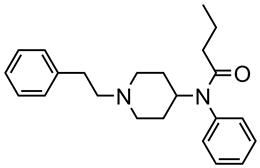
Fentanyl and its clinically used analogs are regarded as highly potent μ-opioid receptor agonists.īesides the medicinal usage and progress in the therapeutic application of opioids, misuse of opioids has always been an issue. Its pharmacological action is 50–100 times more potent than morphine and 25–40 times more than heroin, and it is commonly used in anesthesia and pain treatment ( US Drug Enforcement Administration, 2015 National Institute on Drug Abuse, 2016). Fentanyl has first been synthesized by Paul Janssen in 1959 ( Janssen, 1965) and was derived from the synthetic opioid meperidine. In association with the discovery and deeper investigation of the opioid receptors numerous synthetic, structurally diverse opioids were developed by research chemists and pharmaceutical companies. The first semi-synthetic opioids (such as heroin) were derived from the opium alkaloid morphine. Opiates have been used for thousands of years to treat a broad variety of conditions. Here we present a review on the metabolic profiles of new fentanyl analogs responsible for a growing number of severe and fatal intoxications in the United States, Europe, Canada, Australia, and Japan in the last years, as assessed by a systematic search of the scientific literature and official reports. When analyzing blood and urine samples of acute intoxication cases or fatalities, the presence of metabolites can be crucial for confirmation of the uptake of such compounds and further interpretation. Furthermore, phase II metabolic reactions can be expected comprising glucuronide or sulfate conjugate formation. Considering the well characterized metabolism of the pharmaceutically used opioid fentanyl and the so far available data, the metabolism of the new fentanyl analogs can be anticipated to generally involve reactions like hydrolysis, hydroxylation (and further oxidation steps), N- and O-dealkylation and O-methylation. For some of the compounds, limited information on the metabolism has been published, however, for others so far no information is available. Up to now, little is known about the metabolic pathways of new fentanyl analogs that have recently emerged on the drug markets worldwide with high potential for producing addiction and severe adverse effects including coma and death. 4Unit of Forensic Toxicology, Section of Legal Medicine, Department of Excellence SBSP, Università Politecnica delle Marche, Ancona, Italy.3National Centre on Addiction and Doping, Istituto Superiore di Sanità, Rome, Italy.2Hermann Staudinger Graduate School, University of Freiburg, Freiburg im Breisgau, Germany.1Department of Forensic Toxicology, Institute of Forensic Medicine, Medical Center – University of Freiburg, Faculty of Medicine, University of Freiburg, Freiburg im Breisgau, Germany.

Maurice Wilde 1,2, Simona Pichini 3, Roberta Pacifici 3, Adriano Tagliabracci 4, Francesco Paolo Busardò 4*, Volker Auwärter 1 and Renata Solimini 3


 0 kommentar(er)
0 kommentar(er)
